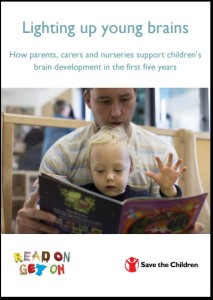Qualified practitioners in the early years: It takes leadership to light up every young brain
4th April 2016
 If we don’t get the Early Years right, it’s not just a question of lost time, it’s a question of brain development: all the phonics flashcards in the world can’t rewind what happens in those crucial years.
If we don’t get the Early Years right, it’s not just a question of lost time, it’s a question of brain development: all the phonics flashcards in the world can’t rewind what happens in those crucial years.
That’s why as an ex-early years teacher, I was hugely excited to read ‘Lighting up Young Brains,’ a briefing published by Save the Children last week that reviews evidence on the link between language and brain development among under-fives. I particularly welcome its key demand that every setting should be have a qualified early years teacher, however, pedagogical skills won’t be enough to transform quality.
Providing an environment that stimulates and supports language development is no easy task and involves carefully nurturing three key skills:
- Attention and listening;
- Physical development of muscle coordination to allow articulation;
- Understanding of the phonological, semantic and syntactic components of language.
Doing this effectively is a skilled process that is often lost on the untrained observer. At initial glance, it might look like children are merrily tossing glitter around – devil may care, whilst the teacher sits happily chatting and enjoying the easy life of ‘glitter and glue in foundation stage’. However, Early Years practitioners watching the aforementioned glitter-shower, will know the profound impact that the nuanced interactions that are taking place will have; they will see that the teacher is engaging in complex conversations exploring the properties of glitter, encouraging children to describe their sensory experience and artfully asking open, thought-provoking questions. (Although none of this is to say we don’t just love glitter for the sake of glitter too).
Given the skilled nature of the early years practitioners’ role, Save the Children are absolutely right to demand that by 2020, every nursery in England should be led by an Early Year’s teacher. Qualified practitioners have been shown to have a positive impact on the quality of Early Years settings. However, this demand is not enough.
In an class of 26 pupils there might be seven to nine staff and if one staff member must be fully qualified, half a dozen don’t have to be. This means that the vast majority of a child’s one-to-one interactions with an adult will be with an unqualified member of staff. In my experience, teaching assistants and support staff are generally highly committed and competent, but if qualified practitioners are to have maximum impact, as well as being able to excel during their own interactions with children, they also need to know how to deploy their colleagues effectively, critically evaluate their practice and feedback sensitively and constructively. Without these leadership skills, qualified practitioners might well ‘light up the young brains’ they are interacting with, but not necessarily all of the brains in their setting.
The ability to lead pedagogy within a setting is not something we can expect staff to do intuitively. So, if we aim to ensure that there is a trained and qualified early years practitioner in every setting by 2020, let’s also make sure they are prepared to lead their team and develop staff too.

Comments